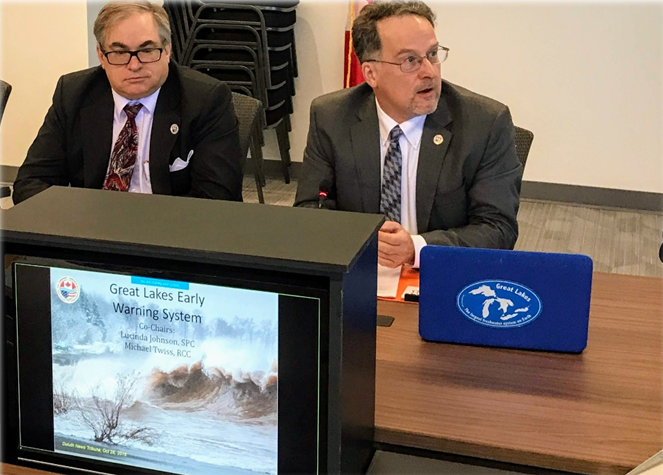By Michael Twiss, Professor, Department of Biology, Algoma University
Algoma University is playing a key role in determining the consequences of oil spills in the Great Lakes, and that work is critical to protecting the wellbeing of all of us who call Sault Ste. Marie home.
Following the official commissioning of the U.S. Coast Guard Great Lakes Center of Expertise at the Center for Freshwater Research and Education of Lake Superior State University (LSSU) on May 10, this an opportune time to underscore the importance of addressing the pressing issue of oil spills and their long-term ecological effects on the Great Lakes.
While the majority of past studies on oil spills have focused on oceanic systems, we must consider the impact of oil spills in freshwater. With more than four million barrels of oil moved through Canada every day via various means, including cargo ships, rail, transport trucks, and pipelines, according to Natural Resources Canada, the risk of oil spills cannot be overstated. Canada’s vast coastline and freshwater resources, totalling over 240,000 kilometers and 890,000 square kilometers, respectively, underscore the importance of understanding and mitigating the impact of oil spills on Canadian ecosystems.
The St. Marys River (Baawaating) is a crucial waterway connecting Lake Superior to the rest of the Great Lakes. It is a meeting place for people, migrating and overwintering waterfowl,and spawning fish. Its location puts at risk human and non-human life since it is also a nexus for industry and shipping.
To this end, the funding by Natural Resources Canada of a multi-million dollar international research network, led by LSSU and Algoma University, acknowledges the importance of this issue. Our network aims to advance understanding of ecosystem-level responses to oil contamination, particularly in coastal wetland ecosystems and nearshore areas of freshwater Great Lakes, especially during cold weather seasons.
Understanding the impact of oil on freshwater ecosystems like the Great Lakes is essential to the design of appropriate clean up, remediation strategies, and action plans. However, can we avoid the risk by banning oil transport on and underneath these globally significant fresh waters?
Opposition exists to both Line 5 the 65-year old oil pipeline that traverses the Straits of Mackinac on the floor of this critical waterway and a proposal to bury the pipeline in a tunnel. Arguably, placing the pipeline in a tunnel would avoid potential catastrophes such as the event on April 1, 2018 when a tugboat anchor dragged along the lakebed through the Straits of Mackinac and accidentally severed three electrical cables belonging to American Transmission Co resulting in the spill of 2,270 litres of mineral oil insulation fluid. The same incident also dented Enbridge Inc.’s Line 5 oil pipeline, risking a major oil spill during winter shipping period when response and containment would have been very difficult if not impossible.
However, decisions to place this tunnel under the Straits of Mackinac have not been approved by the Bay Mills Indian Community, Grand Traverse Band of Ottawa and Chippewa Indians, Little Traverse Bay Band of Odawa Indians, and Nottawaseppi Huron Band of the Potawatomi, whose livelihood is imperilled by the current Line 5 pipeline and who do not trust that the tunnel would alleviate the risk of a catastrophic oil spill.
Therefore, one could view any funding of research on oil spills in the Great Lakes to be shortsighted or avoid the real issue: “Can we afford to transport oil on or below the Great Lakes?”.
The Great Lakes region is collectively the third largest economic bloc in the world, and home to 35 million people in its watershed, Canada, the United States and over 120 First Nations, Indian Tribes, and Métis Nations. Marine diesel is the primary means to move tons of products on the lake but its presence also endangers these waters.
Analysis and discussions of the risk inherent with economic activity on the lakes requires data collection, knowledge of risk and its mitigation, foresight to recognize threats well before their impact, and ways to alert our communities so correct actions can take place. The International Joint Commission (IJC), the organization founded by the 1909 Boundary Waters Treaty between Canada and the United States, aims to prevent and resolve disputes involving shared waters, such as the Great Lakes. Recently, the IJC has approved its Great Lakes Science Advisory Board, to further advance its development of a Great Lakes Early Warning System, by taking on a pilot project to examine threats to water quality. This early warning system will involve all members within the Great Lakes community and recognizes that risk is a social construct, with some communities more tolerant and others more averse to certain types of risk. It is hoped that a successful early warning system will be able to help us solve the difficult issues we face and ideally help us recognize unknown threats before they arrive.On Thursday, June 13, the IJC held a one-hour webinar that included a brief presentation on the Board’s advice for a Great Lakes Early Warning System decision-making framework to assess and respond to potential stressors to Great Lakes water quality before they become established threats. The IJC’s latest reports can be viewed here.
Share Article




